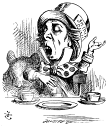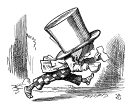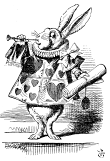Search us!
Search The Word Detective and our family of websites:
This is the easiest way to find a column on a particular word or phrase.
To search for a specific phrase, put it between quotation marks. (note: JavaScript must be turned on in your browser to view results.)
Ask a Question! Puzzled by Posh?
Confounded by Cattycorner?
Baffled by Balderdash?
Flummoxed by Flabbergast?
Perplexed by Pandemonium?
Nonplussed by... Nonplussed?
Annoyed by Alliteration?

Don't be shy!
Send in your question!
Columns from 1995 to 2006 are slowly being added to the above archives. For the moment, they can best be found by using the Search box at the top of this column.
 If you would like to be notified when each monthly update is posted here, sign up for our free email notification list.
If you would like to be notified when each monthly update is posted here, sign up for our free email notification list.
Trivia
All contents herein (except the illustrations, which are in the public domain) are Copyright © 1995-2020 Evan Morris & Kathy Wollard. Reproduction without written permission is prohibited, with the exception that teachers in public schools may duplicate and distribute the material here for classroom use.
Any typos found are yours to keep.
And remember, kids,
Semper Ubi Sub Ubi
|
No surrender.
Dear Word Detective: My father keeps writing “tooth and tong” in our email exchanges but I have never heard that expression from anyone but him. I have always heard that expression as “tooth and nail” but I dare not tell him, even if it’s wrong (although I am not sure that it is). I saw your site so I thought that I would ask you. — John.
There is no “wrong” here, grasshopper. We do not judge. There is only your path, my path, and your father’s path, which just happens to lead to The Most Awesome Cliché Mashup Ever. Seriously, “tooth and tong” is a keeper, and I plan to begin using it as soon as I can find a conversation worthy of its greatness.
Oh, rats. I just made the mistake of Googling “tooth and tong,” and it produced around 40,000 hits for the phrase, so I guess we’re both late to the party on this one. Even Senator Orrin Hatch apparently used the phrase on NPR back in 2009, describing how he and the late Senator Ted Kennedy, although friends, frequently fought “tooth and tong” over legislation. But wait, it gets classier. A book of interviews with writer Truman Capote published in 1987 by Capote and William Inge quotes Capote (speaking of negative reactions to his 1966 book “In Cold Blood”) saying, “Mrs. Meier, wife of the sheriff at the jail, turned against me. And Duane West is one of my bitterest enemies. And they were sort of working tooth and tong.” So I think it’s safe to say that your father is traveling in pretty sophisticated company.
I’m not sure what, if any, technical linguistic term would fit “tooth and tong.” It’s not a “spoonerism” (named after Reverend W.A. Spooner (1844–1930) of Oxford) consisting of the transposition of letters, syllables, etc. (as in “The Lord is a shoving leopard” instead of “loving shepherd”). It’s also not a “malapropism” (from Mrs. Malaprop, a verbally inept character in Richard Sheridan’s 1775 play The Rivals), in which the word used is not quite the one meant (e.g., “The very pineapple of politeness,” rather than “pinnacle”).
So “mashup” will have to do for the moment. The phrases being “mashed up” in “tooth and tong” are both hoary clichés (itself a hoary cliché, of course) that could use a good mashing. The “tooth” comes, as you suspected, from “tooth and nail,” meaning “vigorously, with great determination, employing any means necessary” (“I am ready to oppose any such project tooth and nail,” 1892). The literal basis of the phrase, which dates to the early 16th century, is a fight so fierce that both teeth and nails are employed. The “nails” in the phrase are fingernails, but a common variant in the US, “tooth and toenails,” speaks to an even more savage determination. Devotees of the mani-pedi don’t stand a chance.
The “tong” in “tooth and tong” is borrowed from the phrase “hammer and tongs,” also meaning “with great determination and force,” though it doesn’t carry the same overtones of interpersonal violence as “tooth and nail.” The source here is the blacksmith’s forge, where long-handled tongs are used to pull the metal to be forged from the fire and hold it steady on the anvil while the blacksmith shapes it with blows from a heavy hammer. To undertake a task or a struggle “hammer and tongs” is thus to “go all out,” using great force, persistence and determination (“I work at least 60 hours … You can be going hammer and tongs from 6 in the morning to 12 at night,” The Age (Australia), 7/8/12).
Most of the web hits I found for “tooth and tong” use it in the sense of “tooth and nail” or “hammer and tongs” (the remainder were largely complaints about the “incorrectness” of the phrase). The use of “tooth and tong” by Truman Capote noted above, which is the earliest I can find in print, is interesting because he seems to be using it to mean “in cahoots” (or “hand in glove”) rather than “fiercely.” But he’s not around to ask, so I guess we’ll just have to use “tooth and tong,” however we see fit, in his memory.
Cats are also masters of revenge.
Dear Word Detective: It is possible to pick up, literally, a kitten or small dog, and metaphorically a small child by “the scruff of the neck.” What exactly is a scruff, and are there any scruffs that are not “of the neck”? — Allan Pratt.
Hmm. Folks should be careful about that “scruff of the neck” tactic with dogs and cats. It’s true that parent critters often transport their young for short distances in this fashion. And it’s true that you can temporarily immobilize a cat on a table by firmly grasping the loose skin on the nape of its neck, a secret which can come in handy if you have to give it medicine, teach it Esperanto, or whatever. But I’ve read that you can also inadvertently injure the little creature by doing this, and it’s definitely not a good idea to pick up a grown cat or dog this way, because you’re effectively suspending it in mid-air by its neck.
There are actually two “scruffs” in English, each with both a noun and a verb form, but the odd thing is that neither of them actually started out as “scruff.” The older of the two appeared in the 16th century meaning “a scaly or scabby condition of the skin” or simply “skin flaking; dandruff.” This “scruff” represents a variant spelling of “scurf,” a much older word, meaning roughly the same thing, which has relatives in many European languages and seems to come from an old Germanic root meaning “to gnaw or shred.” This “scruff,” having diverged from “scurf,” lost most of its literal “yucky skin” senses and as a modern noun is used only to mean either “rubbish” or “a dirty or contemptible person.” This noun form of “scruff” is rarely encountered today. But it’s very popular in its adjective form “scruffy,” which can mean anything from excessively dirty, slovenly and possibly savage (“It is because they … live … in a scruffy fashion, following the impulses and necessities of beasts,” 1974) to merely a bit on the shabby side (“Always late, crumpled and scruffy, perpetually in debt, hourly expecting the sack, Greare takes refuge … in Mittyesque fantasies,” TLS, 1958).
The other sort of “scruff” is, as noted, unrelated to the “itchy skin” kind of “scruff.” It first appeared in English in the late 18th century meaning, as it does now, the nape of the neck, the back of the neck at the base of the skull. (“Nape” itself is a bit of a mystery, incidentally. It may come from the Old Frisian “halsknap,” cup, in reference to the hollow at the base of the neck.) By the way, the verb form of this “scruff” means “to seize by the nape of the neck” (“I once had a narrow escape of being ‘scruffed’ by an alligator,” 1885).
But this while this “scruff” has been popular since its first appearance (“He would have fallen overboard, if I hadn’t caught him by the scruff of the neck,” 1834), its original form in English was actually “scuft.” The origin of “scuft” is (predictably) uncertain; it may be related to the North Frisian “scuft” (back of a horse’s neck), the Dutch “schoft” (shoulder), or the Old Norse “skopt” (hair of the head). This “scuft” also produced the variant “scuff,” which may or may not be related in some fashion to the verb “to scuff,” meaning “to brush against lightly” or “to scrape with the feet.”
I’d advise against paying too much attention to any of this “scuft/scuff” business, however. The important part came when people started to use the very similar word “scruff” in place of “scuft” and “scuff” to mean “nape of the neck.” Of course, that meant that English suddenly had two “scruffs,” one meaning “dirt or rubbish” and the other meaning “nape of the neck,” but that doesn’t seem to bother most people.
Kinda like bacon fat, but without the dogs chasing you down the street.
Dear Word Detective: Because I have nothing better to do, I am stuck wondering at the word “dab,” as in “She is a dab hand at sitting around and doing nothing all day.” Does it have anything to do with “dab” as in “a small amount”? — KT.
Good question, and thanks for the trip down memory lane. For those of a certain age and an unruly mind, the mere mention of “dab” meaning “a small amount” will spawn a full mental rendition, complete with orchestration, of the old Brylcreem ad jingle (“Brylcreem, a little dab’ll do ya, Use more, only if you dare, But watch out, The gals will all pursue ya, They’ll love to put their fingers through your hair”). Brylcreem was (and, terrifyingly, apparently still is), a men’s hair styling product made of mineral oil and beeswax. As a small kid, I knew the stuff was popular, but I could not imagine why anyone would want to touch Brycreemed hair. Eww.
“Dab” is one weird little word. Actually, it’s two weird little words which may or may not be related. “Dab” first appeared around 1300 as both a noun and a verb, pretty much ex nihilo, as we say, having had no clear antecedents in English. (It may be related to the Middle Dutch “dabben,” meaning “to knead, pinch,” but there’s no real evidence of a connection.) The original meaning of the verb “to dab” was “to strike lightly or peck,” as a bird might. By the 16th century, this had developed into “to strike, pat or push with a soft, momentary pressure,” as one might “dab” paint onto a surface. (The sense here is similar to that of the unrelated verb “to daub.”) As a noun, “dab” came to mean the small, usually soft bit of some substance (paint, blood, hair grease, etc.) left by the action of “dabbing.” Our English verb “to dabble,” meaning to engage in an activity or interest without serious intent, originally meant “to splash or dab with water,” as children do splashing in puddles.
The use of “dab” you’re asking about is much more recent, first appearing as a noun in the late 17th century meaning “one skillful at” or “an expert in” (“[Love is] such a Dab at his Bow and Arrows,” 1691). The specific form “dab hand,” meaning “someone who is an expert in or proficient at something,” first appeared in the 19th century (“He was a dab hand at water-colours,” 1870). It appeared in many dialect dictionaries in Britain during the 19th century.
Unfortunately, the roots of this “dab” are a complete mystery, so opaque that we don’t know whether it’s even related to “dab” in the “small amount” sense. When this “dab” first appeared it was often described as “school slang,” which, if true, could mean that it either was invented out of thin air or is a heavily modified form of some other word. “Adept” and “dapper” (meaning “neat, trim, smart in appearance”) have been suggested as possible sources. Given the phonetic resemblance between “dab” and “dapper,” I’d vote for “dapper” as a source, but it’s always possible that the other “dab,” the “small amount” sort, was in some way the inspiration. But at this late date we may never find a definitive answer.
|
Makes a great gift! Click cover for more.  
400+ pages of science questions answered and explained for kids -- and adults!
FROM ALTOIDS TO ZIMA, by Evan Morris
 
|


 can be found
can be found 




Recent Comments